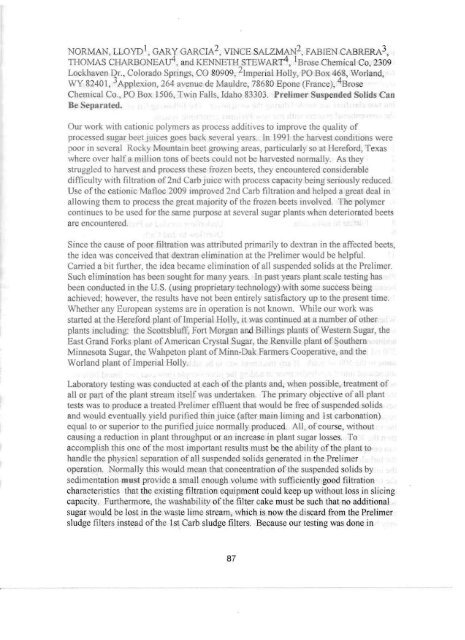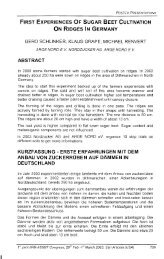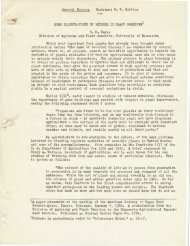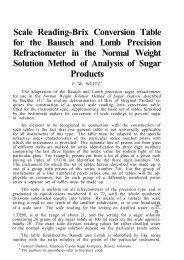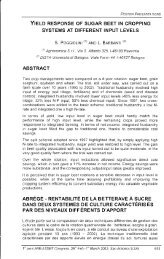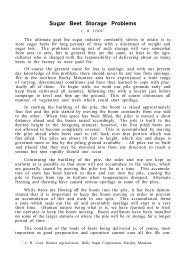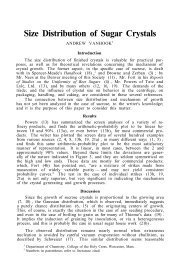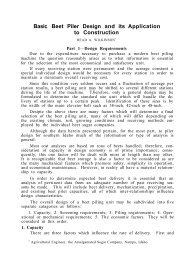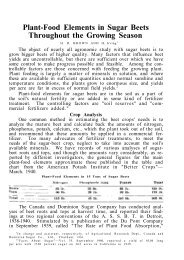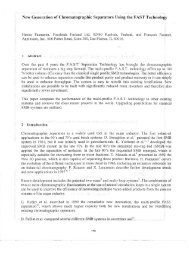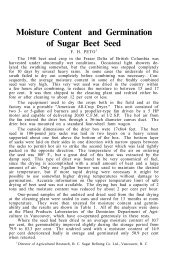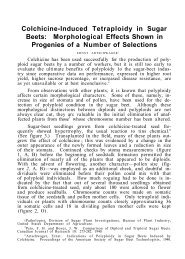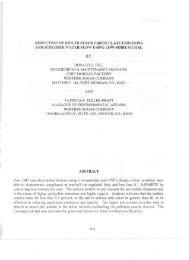Prelimer suspended solids can be separated. - ASSBT Proceedings
Prelimer suspended solids can be separated. - ASSBT Proceedings
Prelimer suspended solids can be separated. - ASSBT Proceedings
Create successful ePaper yourself
Turn your PDF publications into a flip-book with our unique Google optimized e-Paper software.
NORMAN~ LLOYD 1 , GARY GARCIA 2 , VINCE SALZMAN2, FABffiN CABRERA 3 ,<br />
THOMAS CHARBONEAU 4 , and KENNETH STEWART 4 , I Brose Chemical Co, 2309<br />
Lockhaven Dr., Colorado Springs, CO 80909, 2Imperial Holly, PO Box 468, Worland,<br />
WY 82401, 3 Applexion, 264 avenue de Mauldre, 78680 Epone (France), 4Brose<br />
ChemicaJ Co., PO Box 1506, Twin Falls, Idaho 83303 . <strong>Prelimer</strong> Suspended Solids Can<br />
Be Separated.<br />
Our work with cationic polymers as process addjtives to improve the quaJity of<br />
processed sugar <strong>be</strong>et juices goes back several years. In 1991 the harvest conditions were<br />
poor in several Rocky Mountain <strong>be</strong>et growing areas, particularly so at Hereford, Texas<br />
where over half a million tons of <strong>be</strong>ets could not <strong>be</strong> harvested nonnaUy. As they<br />
struggled to harvest and process these frozen <strong>be</strong>ets, they encountered considerable<br />
difficulty with filtration of 2nd Carb juice with process capacity <strong>be</strong>ing seriously reduced.<br />
Use of the cationic Mafloc 2009 improved 2nd Carb fiJtration and helped a great deal in<br />
allowing them to process the great majority oft<strong>be</strong> frozen <strong>be</strong>ets involved. The polymer<br />
continues to <strong>be</strong> used for the same purpose at several sugar plants when deteriorated <strong>be</strong>ets<br />
are encountered.<br />
Since t<strong>be</strong> cause of poor filtration was attributed primarily to dextran in the affected <strong>be</strong>ets,<br />
the idea was conceived that dextran elimination at the Prelirner would <strong>be</strong> helpful.<br />
Carried a bit further, the idea <strong>be</strong>came elimination of all <strong>suspended</strong> <strong>solids</strong> at the <strong>Prelimer</strong>.<br />
Such elimination has <strong>be</strong>en sought for many years. In past years plant scale testing has<br />
<strong>be</strong>en conducted in the U.S. (using proprietary technology) with some success <strong>be</strong>ing<br />
achieved; however, the results have not <strong>be</strong>en entirely satisfactory up to the present time.<br />
Whether any European systems are in operation is not known. While our work was<br />
started at the Hereford plant ofImperiaJ Holly, it was continued at a nwn<strong>be</strong>r of other<br />
plants including: the Scottsbluff Fort Morgan and Billings plants of Western Sugar~ the<br />
East Grand Forks plant of Ameri<strong>can</strong> Crystal Sugar, the Renville plant of Southern<br />
Minnesota Sugar, the Wahpeton plant of Minn-Dak Farmers Cooperative, and the<br />
Worland plant ofImperial Holly_<br />
Laboratory testing was conducted at each ofthe plants and, when possible, treatment of<br />
all or part of the plant stream itself was undertaken. The primary obj ective of aU plant<br />
tests was to produce a treated Pre1imer effluent that would <strong>be</strong> free of <strong>suspended</strong> <strong>solids</strong><br />
and would eventually yield purified thin juice (after main liming and 1st carbonation)<br />
equal to or superior to the purified juice normally produced. All, of course, without<br />
causing a reduction in plant throughput or an increase in plant sugar losses. To<br />
accomplish this one of the most important results must <strong>be</strong> the ability of the plant to<br />
handle the physical separation of all <strong>suspended</strong> <strong>solids</strong> generated in the <strong>Prelimer</strong><br />
operation. NormaJly this would mean that concentration of the <strong>suspended</strong> <strong>solids</strong> by<br />
sedimentation must provide a small enough volwne with sufficiently good filtration<br />
characteri stics that the existing filtration equipment could keep up without loss in slicing<br />
capacity. Furthermore the wa hability of the filter cake must <strong>be</strong> such that no additional<br />
sugar would <strong>be</strong> lost in the waste lime stream, which is now the di scard from the <strong>Prelimer</strong><br />
sludge filters instead of the 1 st Carb sludge filters. Because our testing was done in<br />
87
plants that utilize the conventional separation of precipitated <strong>suspended</strong> <strong>solids</strong> after 1 st<br />
carbonation, where sedimentation in a clarifier is fo llowed by fi ltration of the<br />
concentrated sludge, testing of OUI system on a full plant scale required an extra piece of<br />
equipment--another clarifier. With proper piping plant operators <strong>can</strong> gradually switch<br />
filtration from the conventional processing to our new process wi thout additional filters,<br />
but two clarifiers are needed during the switchover. The fonowing list of steps compares<br />
the conventional process with our new <strong>Prelimer</strong> separation system:<br />
Conventional ] st Carb Separation<br />
l. Raw juice to Pre]jmer<br />
2. <strong>Prelimer</strong> effluent to Main Limer<br />
"J. MainLimer to 1st Carb<br />
4. 1st Carb effluent to clarifier<br />
5. Underflow to fi Itration<br />
6. Overflow & filtrate to 2nd Carb<br />
7. 2nd Carb to filtration<br />
8. Fihrate to sulfitation<br />
9.<br />
10.<br />
11 .<br />
N w <strong>Prelimer</strong> Solids Separation<br />
Raw juice to Pre]jmer<br />
Pre]jmer effluent treated<br />
Treated emuent to clarifier<br />
Underflow to filtratIOn<br />
Overflow & filtrate to Main Limer<br />
Main 1imer to 1 st Carb<br />
1 st Carb to clarifier<br />
Underflow recyled to <strong>Prelimer</strong><br />
Overflow to 2nd Carb<br />
2nd Carb to flitratlOn<br />
Filtrate to sulfitation<br />
Please note that it very well may <strong>be</strong> that double carbonation will not <strong>be</strong> necessary,<br />
<strong>be</strong>cause ofthe elimination ofimpurities at the preli mer and the fact that the juice to the<br />
1st carbonation is clear.<br />
Whenever work was done at any ofthe sugar plants, the first order ofbusiness was to do<br />
some lab scale testing. These tests were to establish the effectiveness of the polymer<br />
additions at the glven time and place. All sedimentation tests were conducted using a<br />
500 ml graduated cylinder. A well stirred sample was poured into the cylinder filling<br />
same to the 500 ml mark. Ifany treatment was to <strong>be</strong> added to the sample it was<br />
introduced into the cylinder prior to adding the juice sample (however, we found Ilttle or<br />
no difference when the treatment was added afterward) The sampJe was then m ixed in<br />
the cylinder using a coited wire stirrer that was passed up and down throllgh the sample<br />
several times. After the stirrer was removed a stop watch was started and the time<br />
requi red for the interface (<strong>be</strong>tween the sludge level and the clear supernatant) to reach<br />
the various levels in the cylinder was noted and recorded (for instance, the 450 ml level.<br />
then the 400 mllevel etc.). By graphing the time required versus the cylinder level one<br />
<strong>can</strong> compare untreated settling rates against various treatments employed. Because of<br />
the turbulence caused by stirring in the cylinder, a sma ll amount oftime is required to get<br />
the interface ofthe sludge level established. This causes a curvature in the upper part of<br />
the time versus interface graph. While this does not cause much of a problem in<br />
comparing graphs, the turbulence effect <strong>can</strong> <strong>be</strong> eliminated by extending the constant<br />
settling rate straight line of the curve back ~ard and moving the entire graph till the<br />
extension passes through zero time and 500 ml. Three or four of the settling rate curves<br />
may <strong>be</strong> superimposed on a single graph fo r easy direct comparison of treatments.<br />
88
In very early \ ork we employed a simple gravity tiltration test. Num<strong>be</strong>r two Whatman<br />
filter paper was used to assure <strong>be</strong>st UI iformity ofth filt r medium. Wepo itioned the<br />
filter fun n I and paper above a graduated c. linder. poured a specific volume of mi,'ed<br />
Pr limer underflO\ into the fi lter and timed the collection of a parti cular volume or<br />
filtrate. Thi method gave us easily comparable reo ults, but did not compare with th<br />
plant filtration conditlOUs Therefore."\ e obtained a 0. 1 sq. ft. te~ t fi lter from the jmco<br />
Company so that " e could more nearly simulate plant condition. TIle test leaf consisted<br />
ofa circular flat plate with fi [trat channels on on side and a collection pipe protruding<br />
from the other A screw on cylinder (the diameter of the filter plate) formed the filter<br />
cake r ceptacle \ hich", when tightened against the flat plate, eal d a circle of filter cloth<br />
<strong>be</strong>tween the cylinder and the plate.::. At each plant we used circles of fi lter cloth taken<br />
from th type of filter cloth used at that plant on their rotary vacuum filters. To use the<br />
test lea \ve attached a sufficientl. long. flexible plastic tu<strong>be</strong> to the coli erion pLpe with<br />
the other end of the plastiC tu<strong>be</strong> cOIll1ected to a source of vaCULun the same as that lIsed in<br />
the plant. TheIL by submerging the assembled test leaf with its circle of filter cloth in a<br />
contai ner of stirred test ampJes we could appl the com parative vacuum for any given<br />
ti me, collect the resultjng filtrate. and ha e information that could <strong>be</strong> dJ rectly related to<br />
plant operations. The filtering b me (time test leaf submerg d) was the same as the time<br />
any giv n part of the rotary filter cloth wa subm rged in the filt r tub 'Ne drained all<br />
filtTate from the pia tic tu<strong>be</strong> and mea w-ed the volume ther of. From th time and<br />
vol ume informati on and knowing that the filter area of the leaf was 0.1 sq. f1 we could<br />
calculate the fil tration effectiveness as gallons per minut per square foot of filter media.<br />
This infonnation c uld then <strong>be</strong> c mpared wi th plant data.<br />
Laboratory analytical info nnation on such important factor as purity, color, clarity, or<br />
any other needed data was provided by the plant laboratory personnel. T heir information<br />
\-vas inval uabl e to us. and \ e especially thank each and very person involved in<br />
gathering this data for their h lp and cooperation.<br />
All samples used in this v.:ork were taken directly from a plant stream and either treated<br />
or 1 ft Lmtreated, as noted ill the text hereof. All were taken as gr b sample and<br />
processed as quickly as possible to avoid spoilage or excessive temp rature drop.<br />
Our first experience \ th addition of the cationic polymer Mafl oe 2009. was in<br />
Decem<strong>be</strong>r, 1992. Grab samples of<strong>Prelimer</strong> effluent (treated in the Lab) reacted<br />
favorably up to 30 ppm in both ettlins and filtration tests (using the simple gravity test<br />
procedure. \ e did not ha e the imco t st leaf at that time). The 30 ppm addition is the<br />
limit allowed by the FDA at 10 percent sugar content in the juice. Addition f the 2009<br />
to samples of 1st Carb effl uent gave similar Improvement in settling and filtering. It was<br />
also noted that addition of a small amount of anionic polymer (Mafl oc 834) gave a<br />
synergistic boost.<br />
We were able to treat the plant <strong>Prelimer</strong> at 20 to 30 ppm for about a day and a half.<br />
During that period then; was the usual mechanical problems that seem to haunt such<br />
89
tests. The variability in operating conditions and the short test time, along with any<br />
changes <strong>be</strong>et quality and/or testing variations, resulted in enatic result . At times it<br />
appeared that there may have <strong>be</strong>en improvement in settling and filtration, but at ti mes no<br />
improvement was indicated. The plant personnel did not notice any adverse effect of any<br />
kind they could contribute to the test. At any rate we were encouraged by the results.<br />
Over the time frame from the first tests at Hereford in 1992 until the present a numb r of<br />
tests were made at several <strong>be</strong>et sugar plants: Imperial HolJy Sugar plants at Worland<br />
Wyoming and Hereford, Texas ~ Western Sugar Co. plants at Scottsbluff, Nebraska,<br />
Billings, Montana, and Ft. Morgan Colorado' Ameri<strong>can</strong> Crystal Sugar Co. plant at East<br />
Grand Forks, Minn esota ~ Southern Minnesota Sugar Co. plant at Renville, Mi nn so t~<br />
and Minn-Dak Farmers Cooperative plant at Wahpeton, North Dakota. At Billings, East<br />
Grand Forks, Renville, and Wahpeton only laboratory testing was conducted. Plant tests<br />
were run at all other plants listed, most tests <strong>be</strong>ing of short duration (a couple of days or<br />
so). Also, most ofthe tests were only involved with polymer treatment at the Preli mer<br />
and evaluation of the settling and filtration qualities of the resulti ng Prelim r effl uent.<br />
In order to properly evaluate the improvement in pJant operation realized from the<br />
<strong>Prelimer</strong> treatment it is necessary that the full plant stream must <strong>be</strong> treated with all of the<br />
<strong>suspended</strong> <strong>solids</strong> removed therefrom. To accomplish tIllSthe plant must <strong>be</strong> capable of<br />
settling and filtering both the <strong>Prelimer</strong> effluent and also the 1 st Carb effluent. The plant<br />
will nonnaJly run with separation of 1 st Carb soLids, but must <strong>be</strong> able to switch over to<br />
separation at the <strong>Prelimer</strong> for the test period. If the plant personnel were willing to risk<br />
starting out with and using the polymer system, only separation equipment at the<br />
<strong>Prelimer</strong> would <strong>be</strong> needed. However, that is a risk that few would wish to take.<br />
At any rate, to properly test the polymer technology, tRe plant needs the capability of<br />
settling <strong>suspended</strong> <strong>solids</strong> both at the <strong>Prelimer</strong> and 1st Carb--usually a clarifier, though<br />
other equipment could <strong>be</strong> utilized. The plant would al so require the capability of<br />
switching on the run from filtering concentrated 1st Carb sludg to filtering concentrated<br />
<strong>Prelimer</strong> sludge. Since there will continue to <strong>be</strong> <strong>suspended</strong> <strong>solids</strong> generat d at 1st Carb<br />
when the <strong>solids</strong> are settled and remo ed at the Preiimer, disposition thereof is requir d.<br />
Cone ntrated sludg from 1st Carb couJd either partially or wholJy sent dire tly to the<br />
fIlter supply tank (for <strong>Prelimer</strong> sl udge) or recycled to the <strong>Prelimer</strong> to provide seed<br />
crystals and bulk for improved settling and filtration. The latter option is sur Iy the<br />
<strong>be</strong>tter, especially when lime addition is cut back to decrease costs. Witb th vast bulk of<br />
precipitable material having <strong>be</strong>en removed from the <strong>Prelimer</strong> effluent, particular! the<br />
fluffy and sticky colloidal types, about all that is precipitated in 1st Carb is rather pure<br />
calcium carbonate crystals having excellent surface characteristics to help gi e good<br />
settling and filtration. The volume of recycle sludge from 1 st Carb to the <strong>Prelimer</strong><br />
should, of course, <strong>be</strong> minimal.<br />
In all testing at the various plants we consistently found that the use of cationic Mafloc<br />
2009 improved both the settling and filtering characteristics of the <strong>suspended</strong> <strong>solids</strong> in<br />
<strong>Prelimer</strong> effluent. Because of the similar results obtained at each plant, we will no<br />
90
include results from each plant. The data we sho\ \ ill <strong>be</strong> typIcal From the total<br />
information gathered we have <strong>be</strong>en able to come to severa l general conclusions The<br />
fo llowing list would <strong>be</strong> incl uded :<br />
1. The addition of cationic pol) mer, MafIoc 20 09, to <strong>Prelimer</strong> j uice sjgniti<strong>can</strong>tly<br />
im proves both the settling and fi1terin~ characteristics of <strong>be</strong> <strong>suspended</strong> <strong>solids</strong> therem.<br />
2. The brreater the amount of 2009 added the greater the improvement realized.<br />
This relationship is good to at least 300 ppm o f added polymer (ppm on t tal j uice). The<br />
limit of addItion established by the FDA is 15 ppm based upon the amount of sugar in the<br />
juice. Tbis limit translates to 30 ppm on juice \: ith 10 percent sugar content. If the sugar<br />
content is higher or lower, the fDA lim it is increased or decreased proportionally . Sinc<br />
normally the sugar content is well above 10 percent, we chose to use 30 ppm as an<br />
arbitrary li mit to stay well ithjn the allowance. Should the uti lization <strong>be</strong>come<br />
commercial, it \ ould <strong>be</strong>hoove the plant operators to monitor and adj ust the addition as<br />
the sugar content changes, <strong>be</strong>cause the greater the addition the greater the effect.<br />
3. The reaction of the 2009 with the soli d particles is not instantaneous We<br />
found that in Lab tests at least 2 minutes reaction time was needed to get conSIstent<br />
results in lab ratory analy es.<br />
4. The point of addition of polymer is important. In plant tests we tried ceU ], 3,<br />
and 5 in the Brieghel-M ull er prelimer. Becall e of the short duration of all test, we<br />
could not determine the oprrmurn. We e entua lly selected Cell 5 as our preferred point,<br />
since this point gi ves plenty of time for reaction, all particles to <strong>be</strong> settled are fully<br />
developed, and the results obtained are good. Nevertheless, we <strong>be</strong>lieve that we do not<br />
necessarily have the optim um poi nt of addition established.<br />
5. Usually, but not al wa s, addition of small amOLmts of anionic polymers had<br />
ad erse affect upon the settling and filtration of <strong>Prelimer</strong> <strong>suspended</strong> <strong>solids</strong>.<br />
6. However, a si gnifi<strong>can</strong>t synergistic boost to the improvement achieved by the<br />
addition of cationic Matloc 2009 was realized when 2 to 5 ppm of anionic polymer was<br />
also add d. here appeared to <strong>be</strong> no clash or neutralization caused by the unlike charges<br />
on the catio nic and anjonic pol lers.<br />
7. AniOniC polymer Applexion Flo Cap 3 is b~ far the <strong>be</strong>st anionic additive that<br />
we have used The combined results are o ften phenomenal. On occasion I have seen<br />
settling rates too fast to <strong>be</strong> able to get good readings. The reaction of this polymer<br />
appears to <strong>be</strong> essentially instantaneous.<br />
8. With removal of the <strong>suspended</strong> <strong>solids</strong> at the <strong>Prelimer</strong> and the resulting <strong>solids</strong><br />
generated at 1st Carb <strong>be</strong>ing white, nearly pure calcium carbonate we <strong>be</strong>lieve that there<br />
would no longer <strong>be</strong> a need for double carbonation. The alkalinity could <strong>be</strong> taken directly<br />
to the m111imumlime salts at 1st Carbo Brief testing of this on the Lab scaJe seemed to<br />
verify the premise; however, we have not tried this at the plant level. 2nd Carb gassing<br />
and 2nd Carb filtration could <strong>be</strong> eliminated with 1st Carb clarifier overflow and filtrate<br />
going directl" to sulfitation and thin juice.<br />
The following Table (Table 1) provi.des typical information regarding the effect ofthe<br />
polymers Matloe 2009 and Applexion Flo Cap 3 upon the settling rates of the <strong>suspended</strong><br />
<strong>solids</strong> in the <strong>Prelimer</strong> effluent<br />
91
TABLE 1<br />
THE EFFECT OF POLYMERS ON SETTLING RATES<br />
Polymer Additions in Parts Per Million<br />
30-2009 30-2009 30-2009 30-2009<br />
(aIQ n~ ) 5 FC3 +1 FC3 +2 Fe3<br />
30-2009<br />
+3 C3<br />
Sludge L vel<br />
Milliliters<br />
450 38 sec 8 sec 11 sec 8 sec 7 sec<br />
400 62 14 l8 12 12<br />
350 87 18 25 . 16 16<br />
300 111 2J<br />
"")<br />
j", 20 20<br />
250 137 24 39 24<br />
")"<br />
L-' <br />
200 26 49 32 30 <br />
175 67 46 41 <br />
150 29 108 76 71 <br />
First note that no untreated settling rate is presented <strong>be</strong>cause the floc formation and<br />
characteristics were such that no sludge-supernatant interface could <strong>be</strong> determined.<br />
Sometimes fairly decent settling rates for the untreated effluent could <strong>be</strong> measrrred, but<br />
quite often the mixture fail ed to clarify in a reasonable length of time. There are some<br />
interesting things demonstrated by this table. For the sample treated with 2009 alone it<br />
took over two minutes to settle to the 250 mi lliliter level; however, in most clarifiers the<br />
residence time is at least 30 minutes. I have seen 1st Carb settling rates no <strong>be</strong>tter than<br />
this. But look at the rates for those samples treated with both the 2009 and the FC3. in<br />
less then two minutes all had settled to the 150 level with the 2009 plus 5 ppm FC3<br />
reaching that level in less than half a min ute. All of the combinations shown in the table<br />
gave excellent settling. Some interesting things show up in the data. For instance, the 2<br />
and 3 ppm FC3 treatments start out <strong>be</strong>tter than the 5ppm, but notice that toward the end<br />
the 5ppm level proves <strong>be</strong>st, as would <strong>be</strong> expected. As mentioned earlier, the turbuJence<br />
from mixing has to subside so that the solid particles, which are going in all directions<br />
when mixed, <strong>can</strong> start their downward motion. Only a second OT two is involved<br />
initially, and, as fast as the settling proceeds, an error ofone second in taking the read1l1g<br />
is quite possible. The reading at the 175 ml level for the 5ppm treatment is absent,<br />
<strong>be</strong>cause in changing from the 50 ml distance to the 25 ml the reading was missed<br />
entirely. These rates are among the <strong>be</strong>st one <strong>can</strong> expect, and don' t forget that j ulce<br />
quality and effectiveness of plant operation will affect the rates.<br />
We <strong>be</strong>lieve that the <strong>be</strong>st information available upon which to j udge the polymer system<br />
with removal of the <strong>suspended</strong> <strong>solids</strong> at the <strong>Prelimer</strong> is that taken at the Worland plant<br />
during the 1997-98 campaign. Two different test periods ere run: Monday (day ending<br />
at 8:00 AM Dec. 9 till Fr iday (day ending Dec. 13, 1997) and Monday (DE Jan 13 ) till<br />
Wednesday (DE Jan 22, 1998). The entire plant stream was treated at the <strong>Prelimer</strong> with<br />
30 ppm cationic Mafloc 2009 introduced into the 5th cell of their Brieghel-Muller<br />
<strong>Prelimer</strong> followed by 2-5 ppm Applexi on Flo Cap 3 anionic polymer added to the<br />
<strong>Prelimer</strong> overflow trough. Each switch from nonna} processing with nonsugar removal<br />
92
from 1 st Carb ffl u nt to pol) mer proce sing v ith nonsugar removal from the <strong>Prelimer</strong><br />
ef1luent was masterfully handl d by the Holly personnel with littl e upset ca used by the<br />
switchover The (i !lowing positi ve statements <strong>can</strong> <strong>be</strong> made about plant operation during<br />
testing:<br />
J. T he settling: of the <strong>Prelimer</strong> sludge in the old Don tank caused little or no<br />
problems as far as clari( o f the rtlO\i was concemd.<br />
2. Plant personnel stated that with the pol_ mer . stem on stream they had <strong>be</strong>tter<br />
operation w ith easi r control both on the remainder of the <strong>be</strong>et end and on the sugar end,<br />
3. With tb principal nonsugar <strong>solids</strong> ha ing <strong>be</strong>en removed at the PreLlmer, the<br />
precipitate at 1st Carb did, indeed, turn white indicating that the <strong>solids</strong> consisted of<br />
relati ely pure calcium carbonate--ideal for recycle to the P relimer.<br />
4. To ee whether or n t lime usage could <strong>be</strong> reduce plant personnel c ut back on<br />
the lime introduced to the Mainl imer--at least 112 for a period of time, 0 adverse<br />
effects could <strong>be</strong> noted when this was done.<br />
The only real problem encow1tered was t<strong>be</strong> illability of the rotary vacuum filters to<br />
handle all the sludge generated at the <strong>Prelimer</strong> clarifier (the old DOfT tank), Part of the<br />
time they did OK, but th y fo ught this station most of the time, This, of course, caused<br />
excessive los of sugar in the Iime waste, a serious economic problem. The filterability<br />
of the generated sl udge was frequently monitored L1si ng oLlr E imco fi Iter leaf to test the<br />
relative rate of filtration. Throughout the test p riods our Lab tests indicated that the<br />
filtration rate should have <strong>be</strong>en sati sfactory~ - at one period during the run we got Eimco<br />
test Jeaf filtering rates that \vere almo t lll1<strong>be</strong>J ievably good; nevertheless, the plant filters<br />
could not keep LIp. One problem V'ias located: Filter leaf tests howed that a much <strong>be</strong>tter<br />
filtration rate was fo und for the et11uent stream directly out oft<strong>be</strong> PreLimer (<strong>be</strong>fore t he<br />
transfer pump) as compared vvith the rat for the feed stream to the fi lter units (after the<br />
transfer pump). S mce a high speed centrifugal pump was used to transfer the effluent<br />
from the <strong>Prelimer</strong> to the filter supply tank it was apparent that the fraf,rile floc particles<br />
were <strong>be</strong>ing damaged by the shearing action of the pump. Replacement ofthat pump with<br />
a variable speed pump helped, but did not sol the problem. It appears evident that<br />
special ha ndling of the eftluent is needed, Table 2 <strong>be</strong>lm shows a comparison of filter<br />
leaf test rates <strong>be</strong>fore versus after the high speed centrifugal pump and the improvement<br />
that was made aft r t he variable speed pump was installed.<br />
TABLE 2<br />
LAB FfLTRATION OF PREUMER SLUDGE<br />
High Speed Pump 12111 /97 Variable Speed Pump 12/12/97<br />
Beror Pump After Pump Before Pump After Pump<br />
Vacuum (nun Hg) 18 20 20 20<br />
Milliliters Filtrate 195 100 160 125<br />
GPM per sq. ft 0.34 0,18 0,28 0.22<br />
Cake thickness (mm) 16 4 9 6<br />
93
Note that with the high speed pump the filtrate recovered is nearly doubled when<br />
filtration is ahead of the pump. 1t will also <strong>be</strong> seen that four times as much susp nded<br />
<strong>solids</strong> were removed. This is surely strong evidence of degradation of the fragile floc<br />
particles by the shear ofthe high speed centrifugal ptunp. With the variable spe d pump<br />
signifi<strong>can</strong>t improvement is shown. Still, the filtrate volume is 28% greater <strong>be</strong>fore the<br />
pump, and the <strong>solids</strong> removal is 50 percent greater. The evidence indicates that the<br />
gentlest possible handling ofthe effluent is imperative.<br />
We had one opportunity to check out our theory that, with OUT polymer separation of the<br />
<strong>suspended</strong> <strong>solids</strong> at the <strong>Prelimer</strong>, double carbonation would <strong>be</strong> unnecessary. We<br />
obtained a large sample ofthe Mainlimer effi uent to 1 st Carb and batch carbonated tl e<br />
sample in the laboratory. As the batch carbonation pro ceded, samples wer removed for<br />
analysis. The pH, Iimesalts. purity. and color was detenn ined for each as shown in the<br />
following Table, Table 3.<br />
TABLE 3<br />
BATCH CARBONATION OF MAfNLIMER EFFLUENT<br />
pH UMESALTS PURITY COLQR<br />
11.9 0. 194 43 L<br />
11 .2 0. 11 ] 93.2 183<br />
10.7 0. 068 92.7 83<br />
10.3 0.064 93.4 91<br />
9.9 0.043 93.2 63<br />
9.4 0.063 93.2 70<br />
Since this is infonnation from only a single laboratory sample, we surely <strong>can</strong>not claim<br />
any proof of anything. We <strong>can</strong>, however say that the data give an indication that we<br />
could indeed eliminate the normal double carbonation. The nonnal 2nd Carb pattern of a<br />
minimum limesalts is indicated, although at a pH of 9.9--higher than the usual 9.2-9.4 or<br />
so. The purity a-ppears to <strong>be</strong> essentially constant, as it should <strong>be</strong> with onJy minimal<br />
elimination ofnonsugars. And the color pattern is also about normal. We e en got the<br />
minimal color at minimum limesalts in the test. Hopefully the premise ofthe single<br />
carbonation will soon <strong>be</strong> resolved at the plant level.<br />
Using assumptions that I felt were reasonable, I made something ofa quick economic<br />
analysis which indicated that, despite the very poor lime waste losses, the periods of<br />
testing may well have <strong>be</strong>en profitable. Obviously, the polymer technology will never <strong>be</strong><br />
adopted until good profitability <strong>can</strong> <strong>be</strong> demonstrated. 1 would li ke to see some of the<br />
plant people study the economjcs thoroughly. In my opinion tie potential for this<br />
technology is great. It only stands to reason that nonsugars, particularly the fluffy, stick),<br />
ones should <strong>be</strong> removed from the process stream as quickly as possible. Removal at the<br />
<strong>Prelimer</strong> is at the first processing step.<br />
94
So. what then remains to <strong>be</strong> done In order to prove the worth of the technology. I feel<br />
that the tests at Worland in 97-98 show that only a little <strong>be</strong>tter filtration i required. A<br />
mode rn automated plate and frame membrane filter station should do the u'ick Just one<br />
supplemental fi lter \. ould do it at Worland, aSSllmll1g that th xtra DOff clarifier is not<br />
dism antled. How much capital money would that tak e') At most other plants a second<br />
clarifier would <strong>be</strong> needed. unl ess so meone is willing to take the big risk of committing to<br />
the technology completely--such ri ks ha e b en tak en Some improvements <strong>can</strong>, 1<br />
<strong>be</strong>lieve, <strong>be</strong> made to improve the 97-98 Wo rl and results. For one, it is the volume of the<br />
sl udge that genera lly causes fil trat ion probkms B cause of the most excellent settling<br />
obtai n d at Worland, perhap el os r and more positi ve control orthe sludge volume<br />
could do the tnck. Concentration to 20% ufthe original volume was realized at<br />
Worland. but what was the average percentage--30%-40 o ;o'> Reduction of those vol umes<br />
to 20% reduces the volume to <strong>be</strong> filtered by :2 '3 and 1/2. How low <strong>can</strong> ( ne go'> Can one<br />
get to 10%, or is even 200,/0 too thick. They found out at Worland that it <strong>can</strong> get too thick<br />
when the DOff agitator stuck and an arm was broken \ h-=:n they restarted. A good look at<br />
this area might yield good returns. Then there is Matloc 2012, the same polymer as 2009<br />
but hav1I1g a higher average molecular \veight. Early Lab tests indicated that 2012 was<br />
Just as good and may<strong>be</strong> <strong>be</strong>tter than 2009. Tb 2009 has <strong>be</strong>en recommended al l along<br />
<strong>be</strong>cause it is a liquid that <strong>can</strong> <strong>be</strong> directl y metered by pump--the 2012 is more viscous and<br />
doesn ' t pump well. I owever, at Worland thin juice was used to dilute the 2009 <strong>be</strong>fore<br />
introduction into the system Such measure might show 2012 superior to 2009. At least<br />
this should <strong>be</strong> checked out.<br />
Then , looking farther 1I1to the future, ultrafiltration has shown more promise of late. Is<br />
this or other new membrane technology out of the questIOn? It WOULd seem doubtful that<br />
raw.i uice <strong>can</strong> ever <strong>be</strong> used in any membrane technology--but how about clarified<br />
<strong>Prelimer</strong>.i uice')<br />
95
Note that with the high speed pump the fi ltrate recovered is nearly doubled v hen<br />
filtration is ahead of the p ump. It will also <strong>be</strong> seen that four times as much <strong>suspended</strong><br />
<strong>solids</strong> were removed. Tbis is surely strong evidence of degradation of the fragile tl oc<br />
particles by the shear of the high speed centrifugal pum p. Wi th the variable speed pump<br />
signifi<strong>can</strong>t improvement is shown. Still, the fi ltrate olume is 28% greater <strong>be</strong>fore the<br />
pump, and the <strong>solids</strong> removal is 50 percent greater. The evidence indicates that the<br />
gentlest possible handling of the effluent is imperative.<br />
We had one opportunity to check out our theory that, with our polymer separation oft<strong>be</strong><br />
<strong>suspended</strong> <strong>solids</strong> at the <strong>Prelimer</strong>, double carbonation would <strong>be</strong> unnecessary. We<br />
obtained a large sample of the M ainlimer effiuent to 1st Carb and batch carbonated the<br />
sample in the laboratory_ As the batch carbonation proceded, sampl s were removed for<br />
analysis. The pH, limesalts, purity, and color was determined for each as shown in the<br />
following Table, Table 3.<br />
TABLE 3<br />
BATCH CARBONATION OF MAINLIMER EFFLUENT<br />
pH LlMESALIS PURITY COLOR<br />
11.9 0.194 43 1<br />
11.2 0.111 93.2 ] 83<br />
10.7 0.068 92.7 83<br />
10.3 0.064 93.4 91<br />
9.9 0.043 93. 2 63<br />
9.4 0.063 93 .2 70<br />
Since this is infonnation from only a single laboratory sample, e surely <strong>can</strong>not claim<br />
any proof ofanything. We <strong>can</strong>, however say that the data give an indication that we<br />
could indeed eliminate the nonnal double carbonation. The nonnal 2nd Carb pattern of a<br />
minimum limesalts is indicated, although at a pH of 9. 9--higher than the usual 9. 2-9.4 or<br />
so. The purity appears to <strong>be</strong> essentially constant, as it should <strong>be</strong> with only minimal<br />
elim ination of nonsugars. And the color pattern is also about norma l. We e en got the<br />
minimal color at mini mum limesalts in the test. Hopefully the premise ofthe single<br />
carbonation will soon <strong>be</strong> resolved at the plant level.<br />
Using assumptions that I felt were reasonable, I made something of a quick economic<br />
analysis which indicated that , despite the very poor lime waste losses, the periods of<br />
testing may well have <strong>be</strong>en profitable. Obviously, the polymer technology will never <strong>be</strong><br />
adopted until good profitability <strong>can</strong> <strong>be</strong> demonstrated. I would li ke to see some of the<br />
plant people study the economics thoroughly. In my opinion the potential for this<br />
technology is great. It only stands to reason that nonsugars, particularly the fluffy, sticky<br />
ones should <strong>be</strong> removed from the process stream as quickly as possible. Removal at the<br />
<strong>Prelimer</strong> is at the first processing step.<br />
96<br />
,-------- --_._--- -


